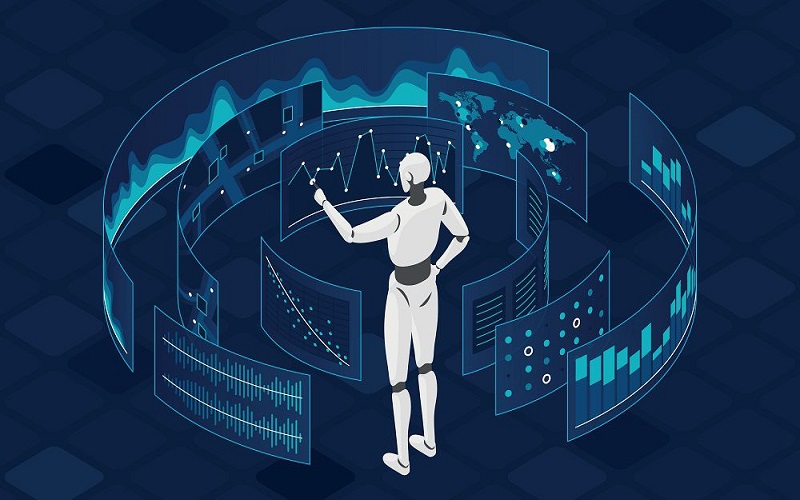The history of artificial intelligence (AI) dates back to ancient times, but the modern development of AI as a scientific field began in the mid-20th century. Here’s an overview of the key milestones and developments in the history of AI:
The Dartmouth Workshop (1956): Considered the birth of AI, a group of researchers, including John McCarthy, Marvin Minsky, Allen Newell, and Herbert A. Simon, organized a workshop at Dartmouth College to explore the potential of “thinking machines” and coined the term “artificial intelligence.”
Early AI Research (1950s-1960s): In the late 1950s and early 1960s, researchers focused on developing AI programs that could solve complex problems using logic and reasoning. This period saw the creation of the Logic Theorist by Allen Newell and Herbert A. Simon, as well as the development of the General Problem Solver by Newell and J.C. Shaw.
Symbolic AI and Expert Systems (1960s-1970s): Symbolic AI, also known as “good old-fashioned AI” (GOFAI), used symbolic representations and logic to mimic human problem-solving. The development of expert systems, which utilized knowledge bases and rules to solve specific problems, became a prominent area of research during this time.
AI Winter (1970s-1980s): The early successes of AI research were followed by a period of reduced funding and interest known as the “AI Winter.” The limitations of existing AI approaches, along with unrealistic expectations, led to skepticism and a decline in support for AI research.
Machine Learning and Neural Networks (1980s-1990s): In the 1980s, researchers shifted their focus towards machine learning, a subfield of AI that focused on developing algorithms capable of learning from and making predictions or decisions based on data. Neural networks, inspired by the structure of the human brain, also gained attention during this time.
Expert Systems Applications (1980s-1990s): Despite the AI Winter, expert systems found applications in various domains, including medicine, finance, and engineering. Systems like MYCIN, which provided diagnostic advice for infectious diseases, demonstrated the practical potential of AI technologies.
Rise of Big Data and AI Resurgence (2000s): The exponential growth of data, along with advances in computing power and algorithms, set the stage for a resurgence in AI research. Machine learning techniques, such as support vector machines and deep learning, gained prominence and achieved impressive results in tasks like image and speech recognition.
Contemporary AI (2010s-2020s): In recent years, AI has made significant strides across various domains. Deep learning, fueled by large datasets and enhanced computing capabilities, has revolutionized fields like computer vision and natural language processing. AI applications are now prevalent in areas such as autonomous vehicles, virtual assistants, recommendation systems, and healthcare diagnostics.
Ethical and Societal Concerns: As AI becomes more powerful and pervasive, discussions about its ethical implications and societal impact have grown. Concerns related to bias in algorithms, privacy, job displacement, and autonomous weapons have sparked debates and calls for responsible AI development.
It’s important to note that the field of AI is constantly evolving, and ongoing research and developments are shaping its history as we move forward.
Features of Artificial Intelligence
Predicting the future of artificial intelligence (AI) is challenging, as the field is rapidly evolving and subject to various factors. However, here are some potential directions and trends that could shape the future of AI:
Advancements in Deep Learning:
Deep learning, a subset of machine learning, has been driving many recent breakthroughs in AI. We can expect further advancements in neural network architectures, training algorithms, and computational infrastructure, enabling even more complex and accurate AI models.
Explainable AI:
As AI systems become more sophisticated and pervasive, there is a growing demand for transparency and explainability. Researchers are exploring ways to make AI systems more interpretable, allowing users to understand how decisions are made and providing insights into the reasoning behind AI-generated outcomes.
AI in Healthcare:
AI has the potential to revolutionize healthcare by aiding in diagnostics, drug discovery, personalized medicine, and patient care. AI-powered systems can analyze vast amounts of medical data, assist in early disease detection, and support medical professionals in decision-making processes.
Autonomous Systems:
The development of autonomous vehicles, drones, and robots is expected to continue advancing. AI will play a crucial role in enabling these systems to navigate, perceive their environments, and make complex decisions independently.
Natural Language Processing and Conversational AI:
Natural language processing (NLP) techniques are evolving, enabling more sophisticated text and voice-based interactions. Conversational AI, including virtual assistants and chatbots, is expected to become more natural and capable of understanding context, emotions, and complex queries.
AI and Ethics:
As AI technologies become more pervasive, there is an increasing focus on ethical considerations. Developers and policymakers are addressing issues such as fairness, bias, privacy, accountability, and the potential societal impact of AI. Responsible AI development and regulation are likely to gain more attention in the future.
AI in Industry and Automation:
AI is transforming various industries, optimizing processes, and automating tasks. From manufacturing and logistics to finance and customer service, AI-powered systems can improve efficiency, productivity, and decision-making, leading to economic and operational advancements.
Human-AI Collaboration:
Rather than replacing humans, AI is expected to augment human capabilities and enable collaboration. AI systems can assist professionals in data analysis, decision-making, and problem-solving, allowing humans to focus on higher-level tasks that require creativity, empathy, and complex reasoning.
Quantum Computing and AI:
The intersection of quantum computing and AI holds great potential. Quantum computers have the capacity to solve certain problems exponentially faster than classical computers, which could significantly impact AI algorithms and enable new capabilities in areas such as optimization, simulation, and cryptography.
It’s important to note that while AI offers immense opportunities, it also raises concerns regarding job displacement, privacy, security, and potential ethical dilemmas. Striking a balance between technological advancement and responsible deployment will be crucial in shaping the future of AI.
Best AI Tools for Business
When it comes to AI tools for business, there are several platforms and solutions available that cater specifically to the needs of businesses. Here are some of the best AI tools commonly used in business settings:
IBM Watson:
IBM Watson offers a wide range of AI-powered services and tools that can be applied to various business domains. It provides natural language processing (NLP) capabilities, chatbot development, image and video analysis, data analytics, and more. Watson’s AI services are known for their versatility and integration options.
Google Cloud AI:
Google Cloud AI provides a suite of AI tools and services that can be utilized for business purposes. It includes pre-trained models for vision, speech, and language tasks, as well as AutoML tools that allow businesses to build custom machine learning models without extensive coding expertise. Google Cloud AI is known for its scalability and integration with other Google Cloud services.
Amazon Web Services (AWS) AI:
AWS offers a comprehensive set of AI services designed to address various business needs. Amazon Rekognition provides image and video analysis capabilities, Amazon Comprehend offers NLP and sentiment analysis, and Amazon Forecast assists in demand forecasting. AWS AI services are highly scalable and can be easily integrated into existing infrastructure.
Microsoft Azure AI:
Microsoft Azure AI provides a wide range of AI tools and services for businesses. Azure Cognitive Services offers pre-built AI capabilities for vision, speech, language, and decision-making tasks. Azure Machine Learning enables businesses to build, deploy, and manage machine learning models at scale. Azure Bot Service allows the development of conversational agents for customer support and engagement.
Salesforce Einstein:
Salesforce Einstein is an AI-powered platform integrated within the Salesforce Customer Relationship Management (CRM) system. It provides AI-driven insights, predictive analytics, and automated decision-making capabilities to enhance sales, marketing, and customer service processes. Salesforce Einstein enables businesses to personalize customer experiences and drive productivity.
DataRobot:
DataRobot is an automated machine learning platform that helps businesses build and deploy predictive models without extensive coding or data science expertise. It automates the end-to-end machine learning workflow, including data preparation, feature engineering, model selection, and deployment. DataRobot empowers businesses to leverage AI and make data-driven decisions.
H2O.ai:
H2O.ai offers a range of AI tools and platforms for businesses, including H2O, Driverless AI, and H2O Q. H2O is an open-source machine learning platform that provides scalable and distributed machine learning capabilities. Driverless AI is an automated machine learning platform that automates feature engineering, model selection, and hyperparameter tuning. H2O Q offers a drag-and-drop interface for building machine learning models.
These AI tools for business can help companies streamline operations, gain insights from data, improve customer experiences, automate processes, and make more informed decisions. The choice of tool depends on the specific requirements and objectives of the business, as well as factors such as integration capabilities, scalability, and ease of use.
Best AI Productivity Tools in 2023
As of my knowledge cutoff in September 2021, I can provide some AI productivity tools that have gained popularity and are likely to continue being valuable in 2023. Please note that the technology landscape is constantly evolving, and new tools may emerge. Here are some of the top AI productivity tools that you may find beneficial:
Grammarly:
Grammarly is an AI-powered writing assistant that helps improve grammar, spelling, and clarity in written content. It provides suggestions and corrections in real-time, making it useful for professionals who need to write clear and error-free documents, emails, and other text-based communications.
x.ai:
x.ai is an AI scheduling assistant that helps with the time-consuming task of scheduling meetings. It can interact with participants via email and find mutually available time slots, eliminating the need for back-and-forth communication. x.ai integrates with popular calendar platforms, making it easy to manage appointments and schedules.
Clara:
Clara is an AI-powered email assistant designed to help manage email overload. It can read, prioritize, and respond to emails on your behalf, allowing you to focus on more important tasks. Clara can handle meeting scheduling, follow-ups, and other email-related activities, saving time and reducing inbox clutter.
RescueTime:
RescueTime is a productivity tool that tracks your digital activities and provides insights into how you spend your time. It helps identify time-wasting activities, set goals, and manage distractions. RescueTime’s AI algorithms analyze your behavior patterns and provide personalized recommendations to improve productivity.
Notion:
Notion is an all-in-one workspace that combines note-taking, project management, and collaboration features. While not exclusively an AI tool, it incorporates AI-driven features like smart templates, database organization, and content suggestions, which enhance productivity and streamline workflows.
Trello:
Trello is a popular project management tool that uses AI capabilities to automate certain processes and improve productivity. It offers features like smart card suggestions, predictive due dates, and workflow automation, making it easier to manage tasks, deadlines, and team collaboration.
Otter.ai:
Otter.ai is a transcription and note-taking tool that uses AI to automatically transcribe audio and video recordings. It provides searchable transcripts and generates meeting summaries, making it convenient for capturing and reviewing important discussions or lectures without the need for manual note-taking.
MindMeister:
MindMeister is an AI-powered mind mapping tool that helps visually organize thoughts, ideas, and concepts. It offers features such as automatic layout adjustment, content suggestions, and collaboration capabilities, enabling efficient brainstorming and knowledge mapping.
Evernote:
Evernote is a versatile note-taking app that leverages AI to enhance productivity. It offers features like smart search, text recognition in images, and suggested tags, making it easier to find and organize information. Evernote’s AI capabilities help streamline information retrieval and knowledge management.
These are just a few examples of AI productivity tools that can assist with various aspects of work and organization. As AI technology continues to evolve, new tools and features may emerge, so it’s always worth staying updated with the latest developments in the field.



